Effects of Wake Separation on Aerodynamic Interference Between Rotors in Urban Low-Altitude UAV Formation Flight
Abstract
1. Introduction
2. Experimental Approach
2.1. Wind Tunnel and Test Bench
2.2. Propeller Geometry
2.3. Test Conditions and Parameter Definition
3. Numerical Approach
3.1. CFD Methodology
3.2. Meshing
3.3. CFD Validation
4. Result and Analysis
4.1. The Effect of Aerodynamic Interference During Hover Flight
4.2. The Effect of Aerodynamic Interference During Vertical Flight
4.3. The Effect of Aerodynamic Interference During Horizontal Flight
5. Conclusions
- (1)
- Hover flight: When the lateral separation is X = 0D, and the axial separation is between 1.0D and 3.0D, the aerodynamic performance of the bottom rotor is significantly reduced, with the thrust coefficient decreasing by nearly 45%. As the lateral and axial separations increase, the bottom rotor gradually moves out of the severe interference region, leading to a gradual rise in its thrust coefficient. While the axial separation remains constant, the thrust coefficient continues to increase with lateral separation, although the rate of increase diminishes as the axial separation grows. The simulation results indicate that when the lateral separation between the two rotors is X = 0D, the velocity field of the rotors exhibits good symmetry. However, when a lateral separation exists, the flow field around the bottom rotor becomes distinctly asymmetric. The inner wake of the rotor features higher velocity but a shorter development distance, while the outer wake has a lower velocity but a longer development distance. The wake flow field of the bottom rotor is highly sensitive to changes in the inflow over the upper surface of the rotor disk. In hovering conditions, it is recommended to maintain a lateral separation of X ≥ 1D or an axial separation of 11D.
- (2)
- Vertical flight: When the rotor separation is small, the thrust coefficient decreases the most at the lateral separation X = 0D. For example, the thrust coefficient at the axial separation Z = 1D is reduced by nearly 50%. When the bottom rotor is affected by the wake, the decrease in the thrust coefficient becomes significant as the flight speed increases. As the axial separation increases, the rotor’s thrust coefficient at X = 1D is the largest. When the rotor is rotating at 5000 RPM, and the flight speed is 2 m/s, the rotor’s thrust coefficient can reach 87% of the isolated rotor’s thrust coefficient, and at 5 m/s, it can remain above 83%. In addition, the flow field pattern of the rotor’s cross-section speed is affected by the flight speed and rotor rotational speed. For a rotor with a speed of 5000 RPM and a flight speed of 2 m/s, only the low-speed airflow on the outer periphery of the wake is affected and gradually disappears. When the flight speed increases to 5 m/s, the rotor wake shows a tendency to shrink. It is recommended that when the axial separation is small, the lateral separation should be greater than or equal to 1D; when the lateral separation is X = 0D, the axial separation should be greater than or equal to 11D. In order to avoid a significant decrease in the thrust coefficient due to high-speed flight, the flight speed should be controlled appropriately.
- (3)
- Horizontal flight: The wake from the top rotor significantly affects the thrust coefficient of the bottom rotor, even at larger lateral separations. The extent of this influence is closely related to the rotor’s RPM and horizontal flight speed. The experimental results indicate that under wake interference, the thrust coefficient can decrease by up to 40%. For horizontal flight at a speed of 2 m/s, it is recommended that the lateral separation between the rotors be X ≥ 4.0D. At flight speeds of 5 m/s or higher and axial separation of Z = 1.5D, the rotor thrust coefficient remains above 90% of the isolated rotor’s thrust coefficient. When Z = 2.5D, the thrust coefficient stays above 95% of the isolated rotor’s thrust coefficient across the entire lateral separation. The velocity field analysis shows that during horizontal flight, the rotor wake inclines toward the side and rear. As the flight speed increases, the angle of inclination of the wake also increases, concentrating the flow region and expanding the range of lateral interference. Additionally, at higher flight speeds with lower rotor RPM, the wake intensity decreases, and the wake development distance shortens. Based on both experimental and simulation results, it is recommended to increase the lateral separation to reduce wake interference during high-speed horizontal flight while the axial separation can be appropriately reduced.
Author Contributions
Funding
Data Availability Statement
Conflicts of Interest
References
- Gillis, D.; Petri, M.; Pratelli, A.; Semanjski, I.; Semanjski, S. Urban Air Mobility: A State of Art Analysis. In Proceedings of the Computational Science and Its Applications—ICCSA 2021, Cagliari, Italy, 13–16 September 2021; Gervasi, O., Murgante, B., Misra, S., Garau, C., Blečić, I., Taniar, D., Apduhan, B.O., Rocha, A.M.A., Tarantino, E., Torre, C.M., Eds.; Springer: Cham, Switzerland, 2021; pp. 411–425. [Google Scholar]
- Pak, H.; Asmer, L.; Kokus, P.; Schuchardt, B.I.; End, A.; Meller, F.; Schweiger, K.; Torens, C.; Barzantny, C.; Becker, D.; et al. Can Urban Air Mobility become reality? Opportunities and challenges of UAM as innovative mode of transport and DLR contribution to ongoing research. Ceas Aeronaut. J. 2024, 1–31. [Google Scholar] [CrossRef]
- Archdeacon, J.L.; Iwai, N. Aerospace cognitive engineering laboratory (acelab) simulator for urban air mobility (uam) research and development. In Proceedings of the AIAA Aviation 2020 Forum, online, 15–19 June 2020; p. 3187. [Google Scholar]
- Koumoutsidi, A.; Pagoni, I.; Polydoropoulou, A. A new mobility era: Stakeholders’ insights regarding urban air mobility. Sustainability 2022, 14, 3128. [Google Scholar] [CrossRef]
- Kiesewetter, L.; Shakib, K.H.; Singh, P.; Rahman, M.; Khandelwal, B.; Kumar, S.; Shah, K. A holistic review of the current state of research on aircraft design concepts and consideration for advanced air mobility applications. Prog. Aerosp. Sci. 2023, 142, 100949. [Google Scholar]
- Wang, L.; Deng, X.; Gui, J.; Jiang, P.; Zeng, F.; Wan, S. A review of urban air mobility-enabled intelligent transportation systems: Mechanisms, applications and challenges. J. Syst. Archit. 2023, 141, 102902. [Google Scholar] [CrossRef]
- Phadke, A.; Medrano, F.A.; Chu, T.; Sekharan, C.N.; Starek, M.J. Modeling Wind and Obstacle Disturbances for Effective Performance Observations and Analysis of Resilience in UAV Swarms. Aerospace 2024, 11, 237. [Google Scholar] [CrossRef]
- Wang, Z.; Wang, T.; Li, T.; Mao, Z. Distributed observer-based close formation control for UAV swarm under outside disturbances and wake interferences. J. Frankl. Inst. 2024, 361, 106651. [Google Scholar] [CrossRef]
- Throneberry, G.; Hocut, C.; Abdelkefi, A. Multi-rotor wake propagation and flow development modeling: A review. Prog. Aerosp. Sci. 2021, 127, 100762. [Google Scholar] [CrossRef]
- Baculi, J.E.; Nguyen, N.T.; Okolo, W.; Xiong, J. Wake Vortex Effects Between Urban Air Mobility Aircraft. In Proceedings of the AIAA SciTech 2023 Forum, National Harbor, MD, USA, 23–27 January 2023; p. 1558. [Google Scholar]
- Wang, C.H.J.; Nathanael, J.C.; Ng, E.M.; Ng, B.F.; Low, K.H. Framework for the estimation of safe wake separation distance between same-track multi-rotor UAS. In Proceedings of the AIAA SciTech 2021 Forum, online, 11–15 January 2021; p. 0708. [Google Scholar]
- Sengupta, B.; Lee, Y.; Araghizadeh, M.; Myong, R.; Lee, H. Comparative Analysis of Direct Method and Fast Multipole Method for Multirotor Wake Dynamics. Int. J. Aeronaut. Space Sci. 2024, 25, 789–808. [Google Scholar] [CrossRef]
- Abras, J.; Hariharan, N.S.; Narducci, R.P. Wake breakdown of high-fidelity simulations of a rotor in hover. In Proceedings of the AIAA SciTech 2019 Forum, San Diego, CA, USA, 7–11 January 2019; p. 0593. [Google Scholar]
- Chen, M.; Hua, J.; Shen, J.; Hubner, J. Tip vortex trajectory and its application in small-rotor/wing interaction. In Proceedings of the AIAA SciTech 2024 Forum, Orlando, Fl, USA, 8–12 January 2024; p. 2846. [Google Scholar]
- Caprace, D.G.; Chatelain, P.; Winckelmans, G. Wakes of rotorcraft in advancing flight: A large-eddy simulation study. Phys. Fluids 2020, 32, 087107. [Google Scholar] [CrossRef]
- Abras, J.; Narducci, R.P.; Hariharan, N.S. Impact of high-fidelity simulation variations on wake breakdown of a rotor in hover. In Proceedings of the AIAA SciTech 2020 Forum, Orlando, FL, USA, 6–10 January 2020; p. 0531. [Google Scholar]
- Ventura Diaz, P.; Yoon, S. High-fidelity computational aerodynamics of multi-rotor unmanned aerial vehicles. In Proceedings of the 2018 AIAA Aerospace Sciences Meeting, Kissimmee, FL, USA, 8–12 January 2018; p. 1266. [Google Scholar]
- Caprace, D.G.; Diaz, P.V.; Yoon, S. Simulation of the Rotorwash Induced by a Quadrotor Urban Air Taxi in Ground Effect. In Proceedings of the Vertical Flight Society’s 79th Annual Forum & Technology Display, West Palm Beach, FL, USA, 16–18 May 2023. [Google Scholar]
- Li, Y.; Ma, Z.; Zhou, P.; Zhong, S.; Zhang, X. A numerical investigation of the aerodynamic and aeroacoustic interactions between components of a multi-rotor vehicle for urban air mobility. J. Sound Vib. 2024, 571, 118002. [Google Scholar] [CrossRef]
- Ignatkin, Y.; Makeev, P.; Konstantinov, S.; Shomov, A. Modelling the helicopter rotor aerodynamics at forward flight with free wake model and URANS method. Aviation 2020, 24, 149–156. [Google Scholar] [CrossRef]
- Bardera Mora, R.; Matías García, J.C. Helicopter rotor ground effect and frigate interaction investigated by particle image velocimetry. AIAA J. 2022, 60, 129–143. [Google Scholar] [CrossRef]
- Wu, Z.; Zhang, T.; Tan, H.; Zhou, H.; Chen, W.; Xie, M. Hovering rotor aerodynamics in extreme ground effect. Chin. J. Aeronaut. 2024, 37, 204–219. [Google Scholar] [CrossRef]
- Otsuka, H.; Kohno, M.; Nagatani, K. Fountain Flow Visualization in Quadrotor Wake Decreasing Rotor Thrust In-Ground Effect. J. Aircr. 2024, 61, 761–773. [Google Scholar] [CrossRef]
- Atte, A. Investigation of Rotor Vertical Offset Effects on Quadrotor Performance. In Proceedings of the Vertical Flight Society 80th Annual Forum, Montréal, QC, Canada, 7–9 May 2024. [Google Scholar]
- Cornelius, J.; Schmitz, S.; Palacios, J.; Juliano, B.; Heisler, R. Rotor Performance Predictions for Urban Air Mobility: Single vs. Coaxial Rigid Rotors. Aerospace 2024, 11, 244. [Google Scholar] [CrossRef]
- Grande, E.; Shubham, S.; Avallone, F.; Ragni, D.; Casalino, D. Computational aeroacoustic study of co-rotating rotors in hover. Aerosp. Sci. Technol. 2024, 153, 109381. [Google Scholar] [CrossRef]
- Shaoqiang, H.; Wenping, S.; Zhonghua, H.; Jianhua, X. A high-resolution numerical investigation of unsteady wake vortices for coaxial rotors in hover. Chin. J. Aeronaut. 2024; in press. [Google Scholar]
- Ko, J.; Lee, S. Numerical investigation of inter-rotor spacing effects on wake dynamics of coaxial rotors. J. Aircr. 2021, 58, 363–373. [Google Scholar] [CrossRef]
- Zhao, M.; Wei, W.; Ke, Z.; Meng, Q.; Tu, J.; Shu, Y.; Zhang, H. Research on Aerodynamic Characteristics and Pitch Regulated Control Strategy of Coaxilcopter with Variable Rotor Spacing. Preprints 2024. [Google Scholar] [CrossRef]
- Barbely, N.L.; Komerath, N.M. Coaxial rotor flow phenomena in forward flight. In Proceedings of the 2016 International Powered Lift Conference (IPLC)/SAE Aerospace Systems and Technology Conference, Hartford, CT, USA, 27–29 September 2016. No. ARC-E-DAA-TN31139. [Google Scholar]
- Yuan, X.; Bian, W.; Zhao, Q.; Zhao, G. Numerical investigation of aerodynamic interactions for the coaxial rotor system in low-speed forward flight. Aerosp. Sci. Technol. 2024, 149, 109148. [Google Scholar] [CrossRef]
- Lakshminarayan, V.K.; Baeder, J.D. Computational investigation of microscale coaxial-rotor aerodynamics in hover. J. Aircr. 2010, 47, 940–955. [Google Scholar] [CrossRef]
- Silwal, L.; Bhagwat, M.; Raghav, V. Aerodynamic Interactions of Counter-Rotating Coaxial Rotors Hovering in Ground Effect. J. Aircr. 2022, 59, 1416–1425. [Google Scholar] [CrossRef]
- Feil, R.; Rauleder, J.; Cameron, C.G.; Sirohi, J. Aeromechanics analysis of a high-advance-ratio lift-offset coaxial rotor system. J. Aircr. 2019, 56, 166–178. [Google Scholar] [CrossRef]
- Feil, R.; Rauleder, J.; Hajek, M.; Cameron, C.G.; Sirohi, J. Computational and experimental aeromechanics analysis of a coaxial rotor system in hover and forward flight. In Proceedings of the 42nd European Rotorcraft Forum, Lille, France, 5–8 September 2016. [Google Scholar]
- Garofano-Soldado, A.; Heredia, G.; Ollero, A. Aerodynamic interactions of non-planar rotor pairs and model derivation in ground approach. Aerosp. Sci. Technol. 2023, 142, 108672. [Google Scholar] [CrossRef]
- Zhu, H.; Deng, S.; Wei, S.; Nie, H.; Wei, X. Experimental Investigation on Thrust Performance of a Small-Scale Staggered Rotor System in Hover. Drones 2023, 7, 677. [Google Scholar] [CrossRef]
- Zhu, H.; Wei, S.; Nie, H.; Du, Y.; Wei, X. Ground Effect on the Thrust Performance of Staggered Rotor System. Drones 2024, 8, 118. [Google Scholar] [CrossRef]
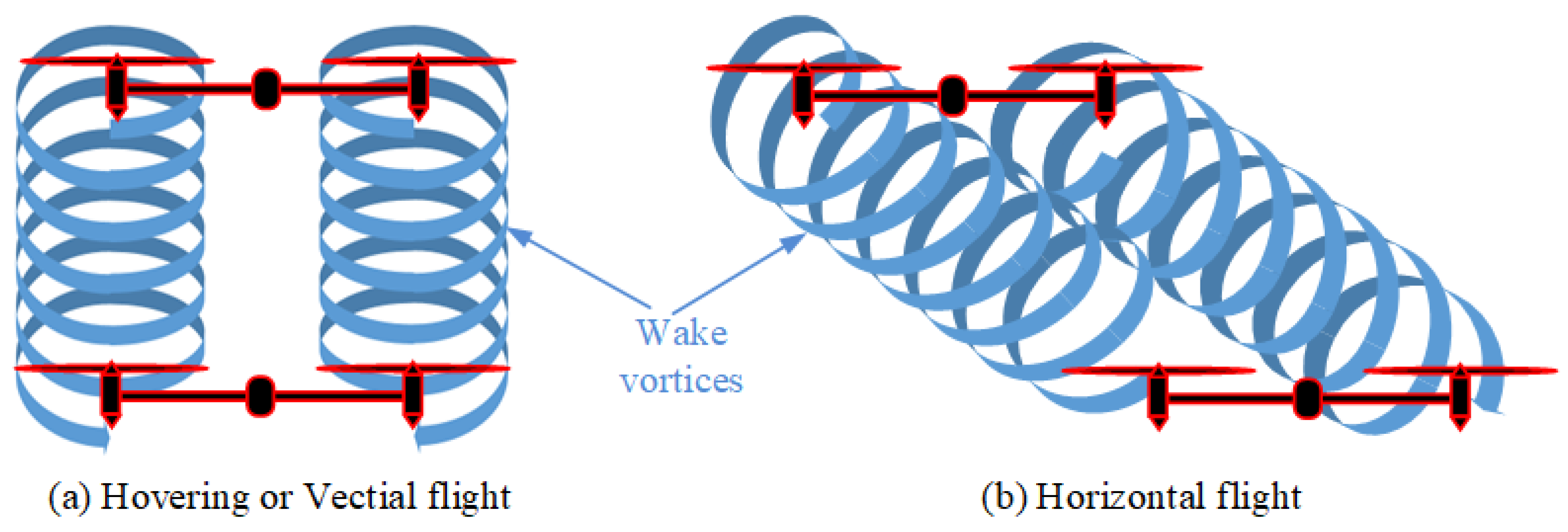

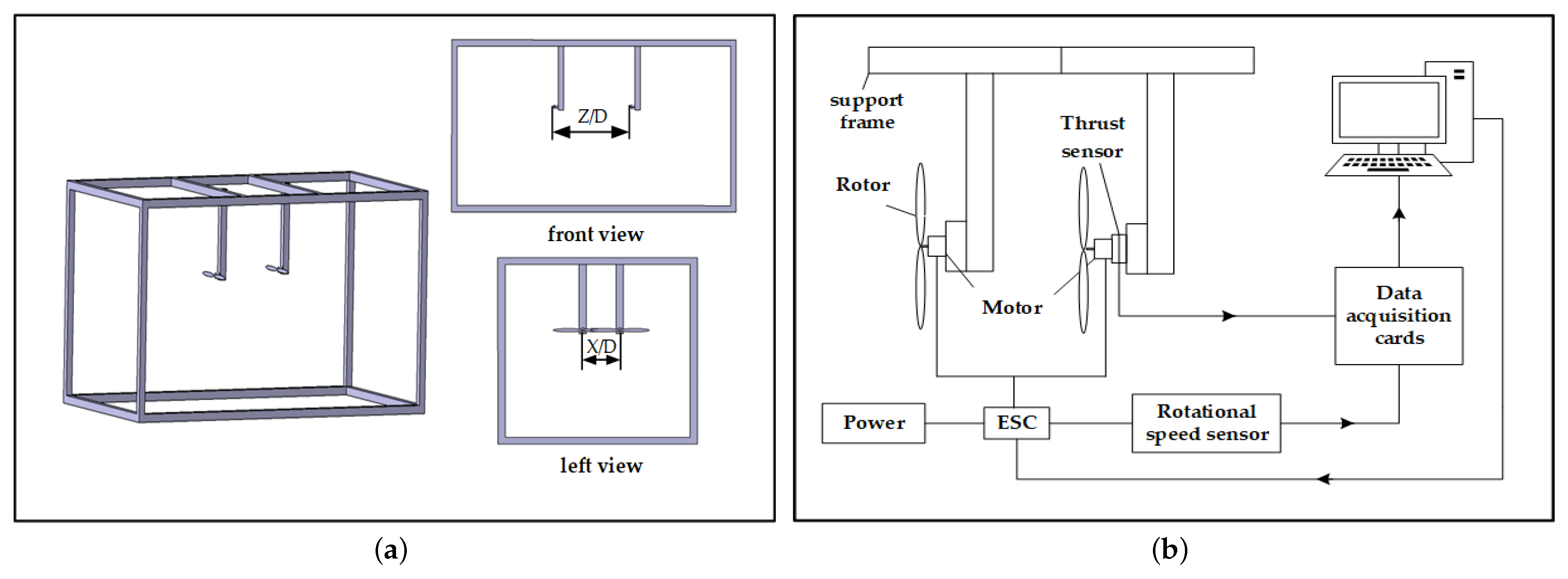
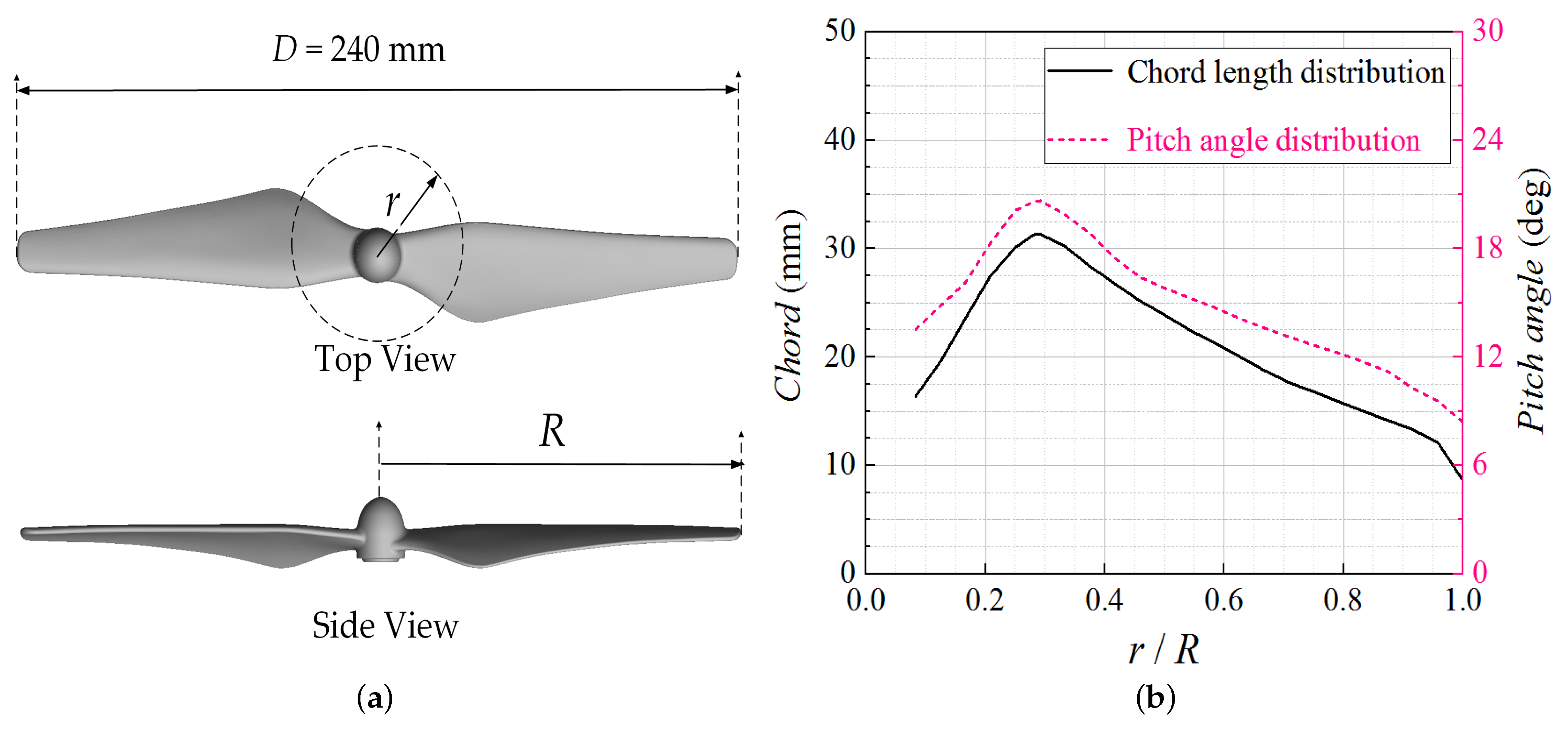
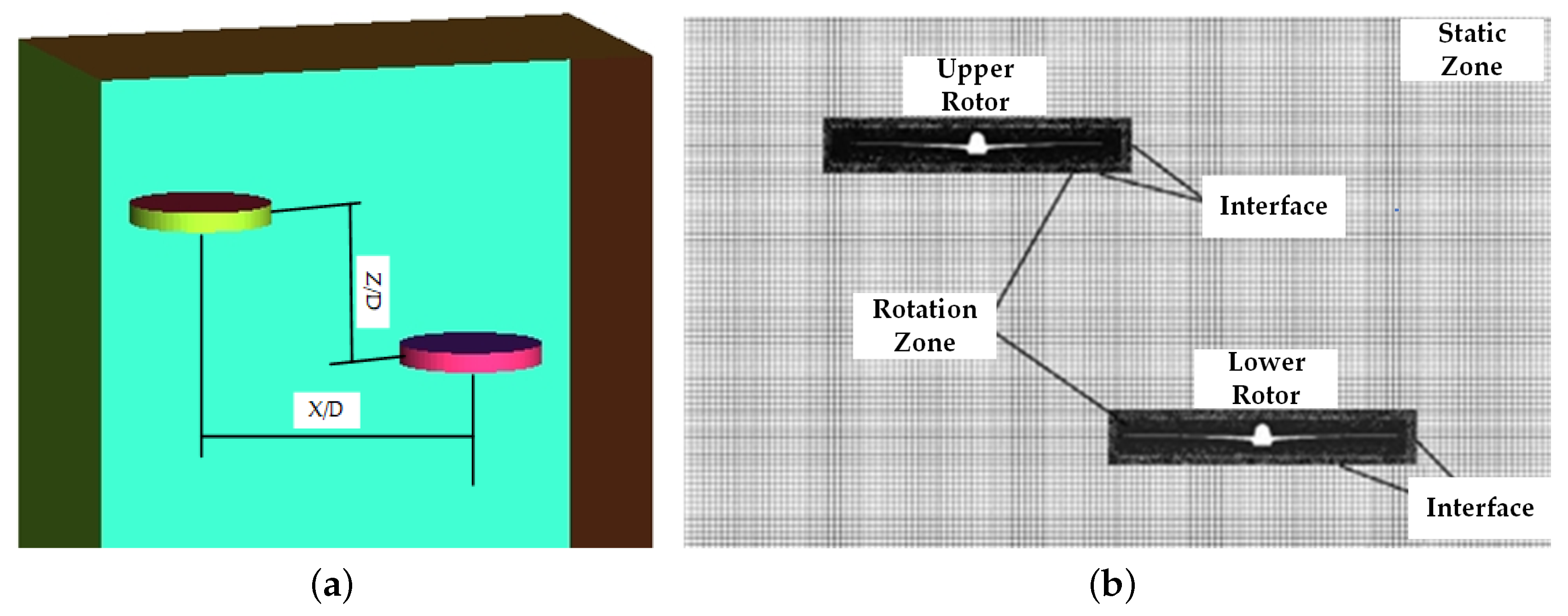



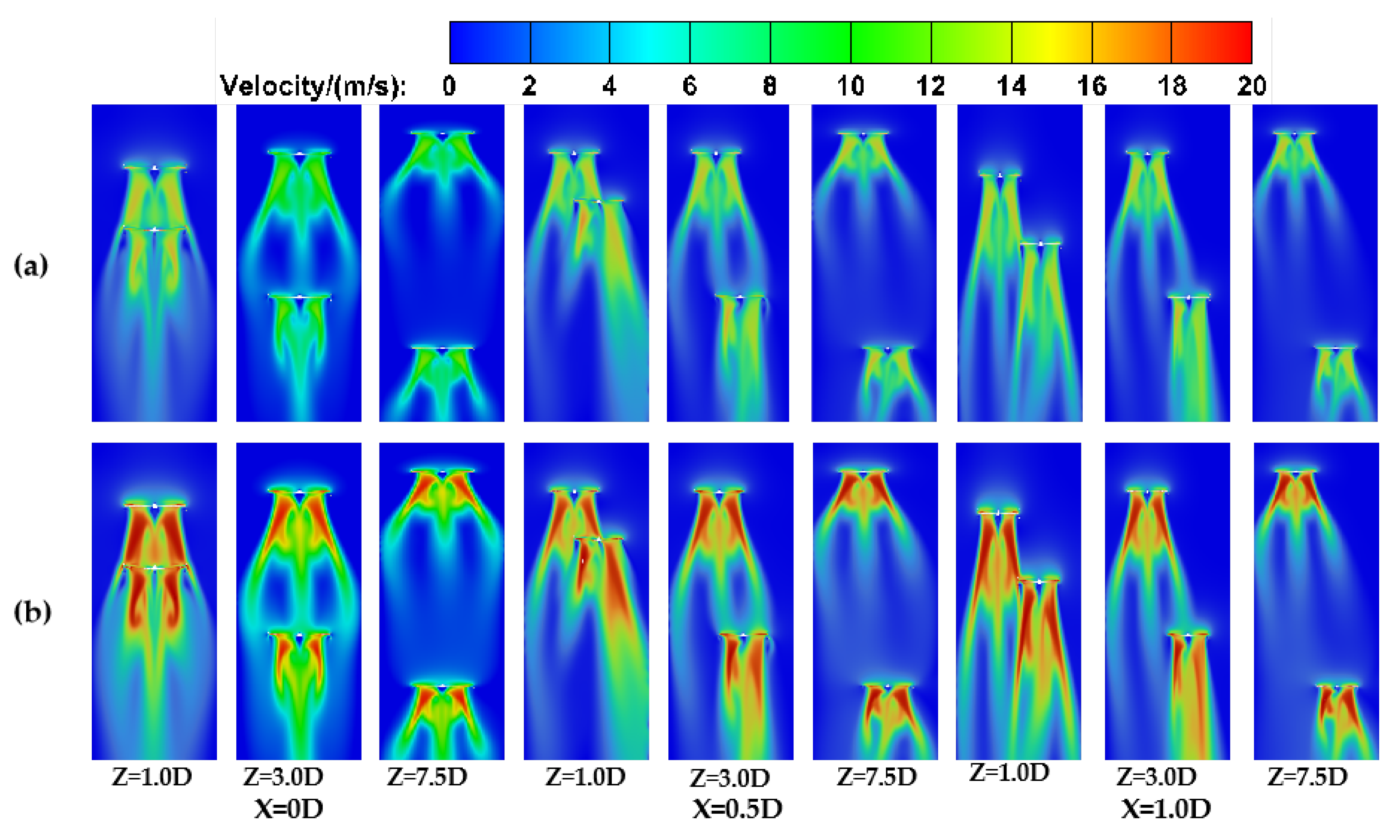
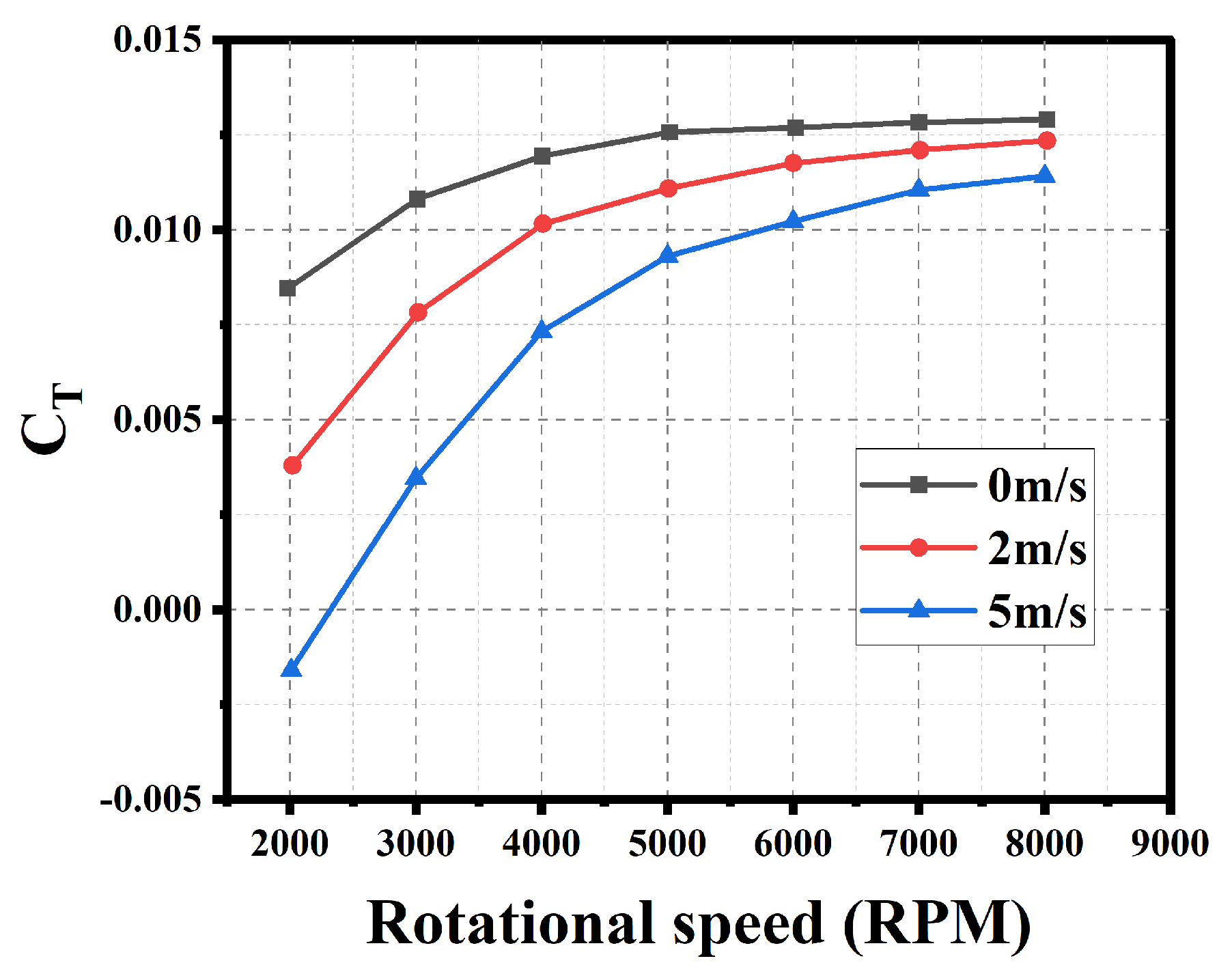
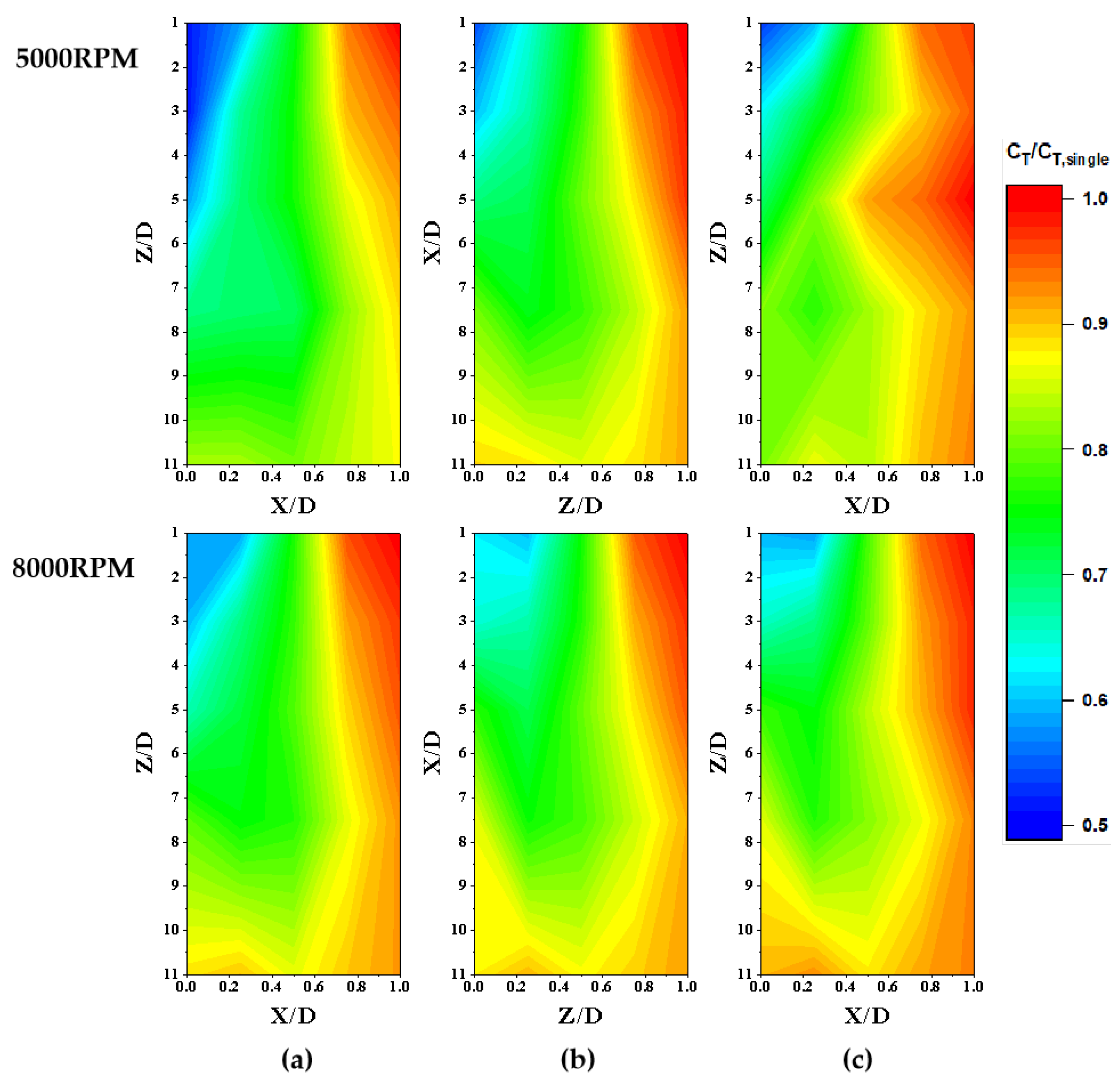



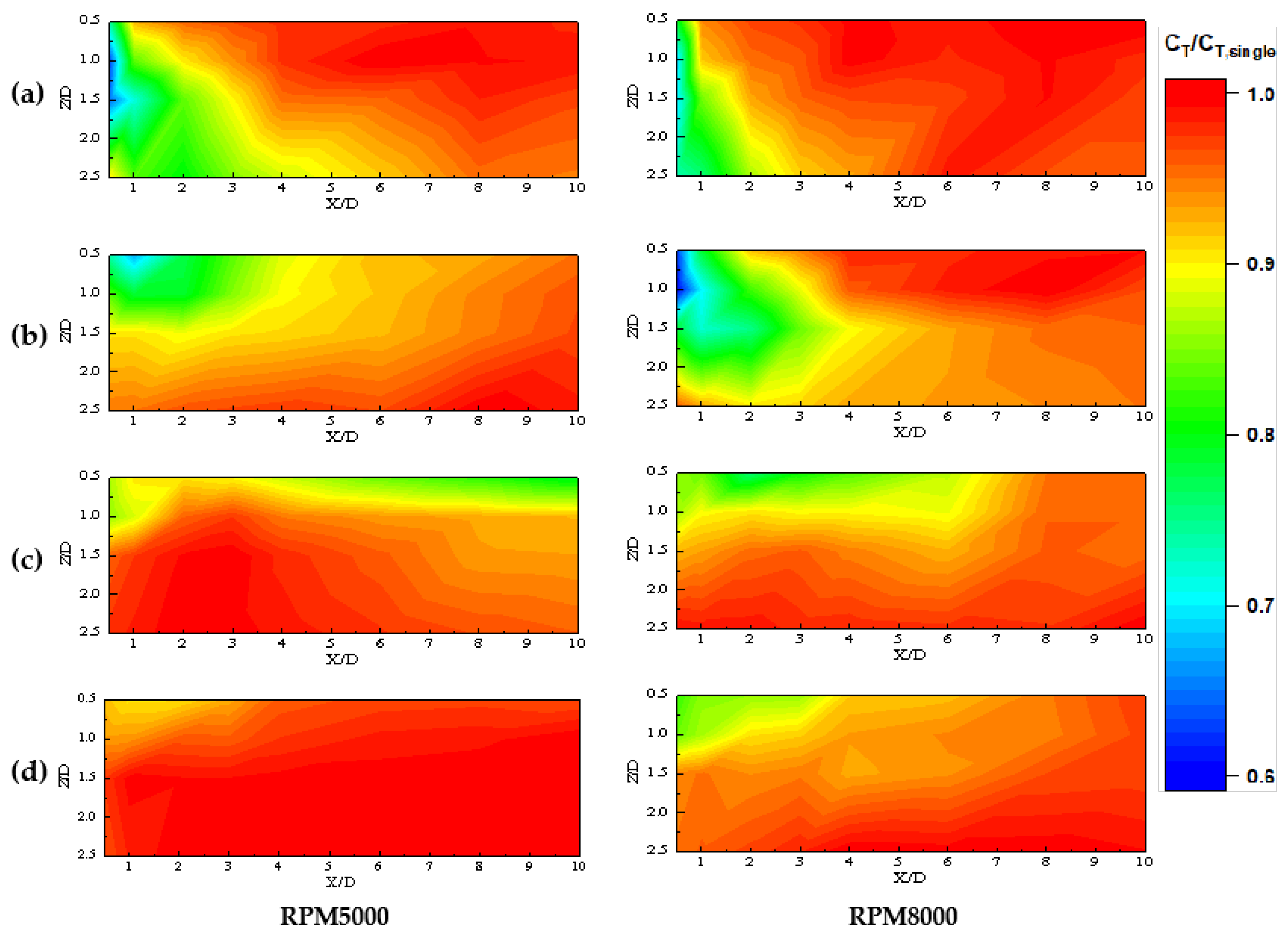

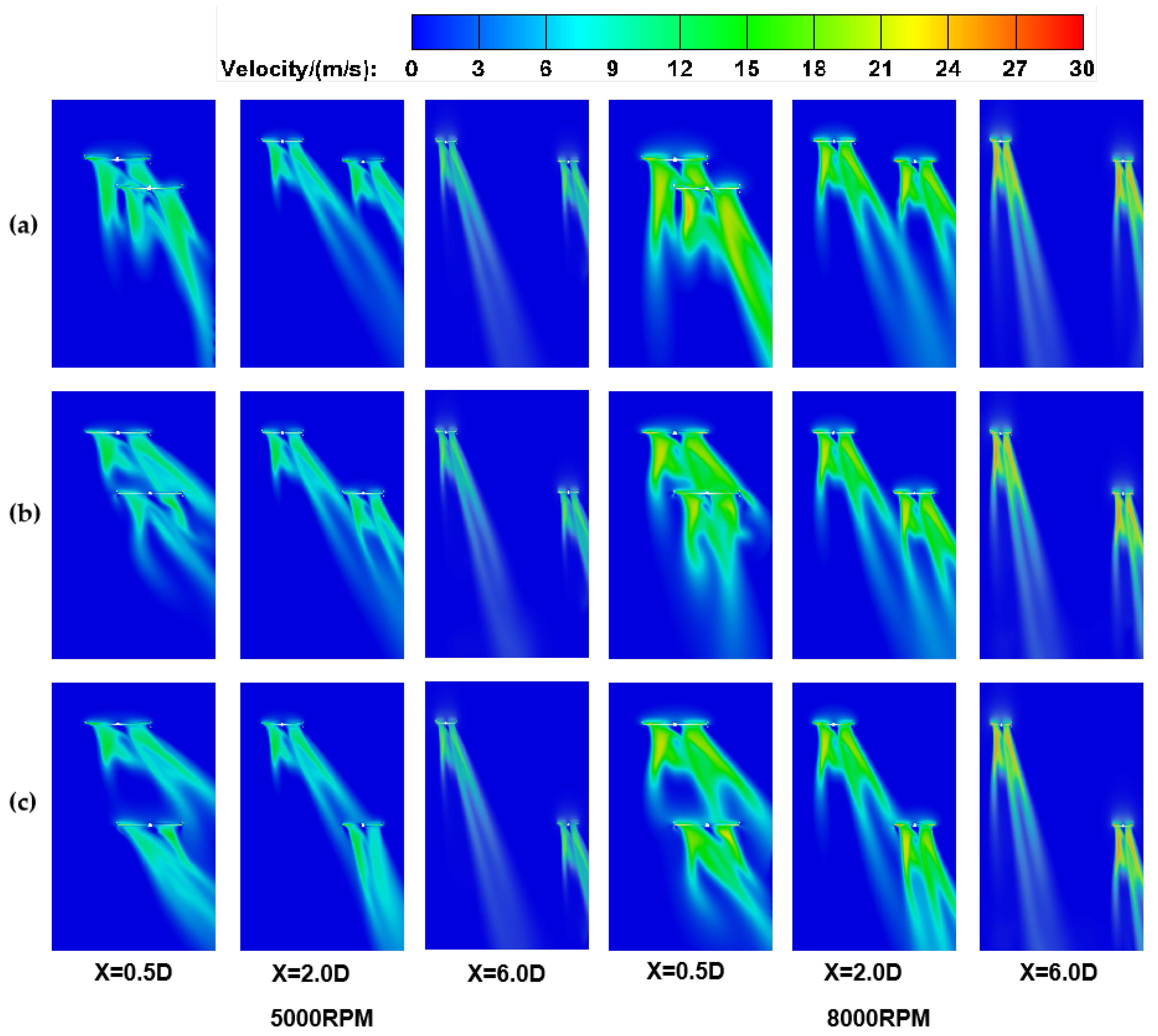
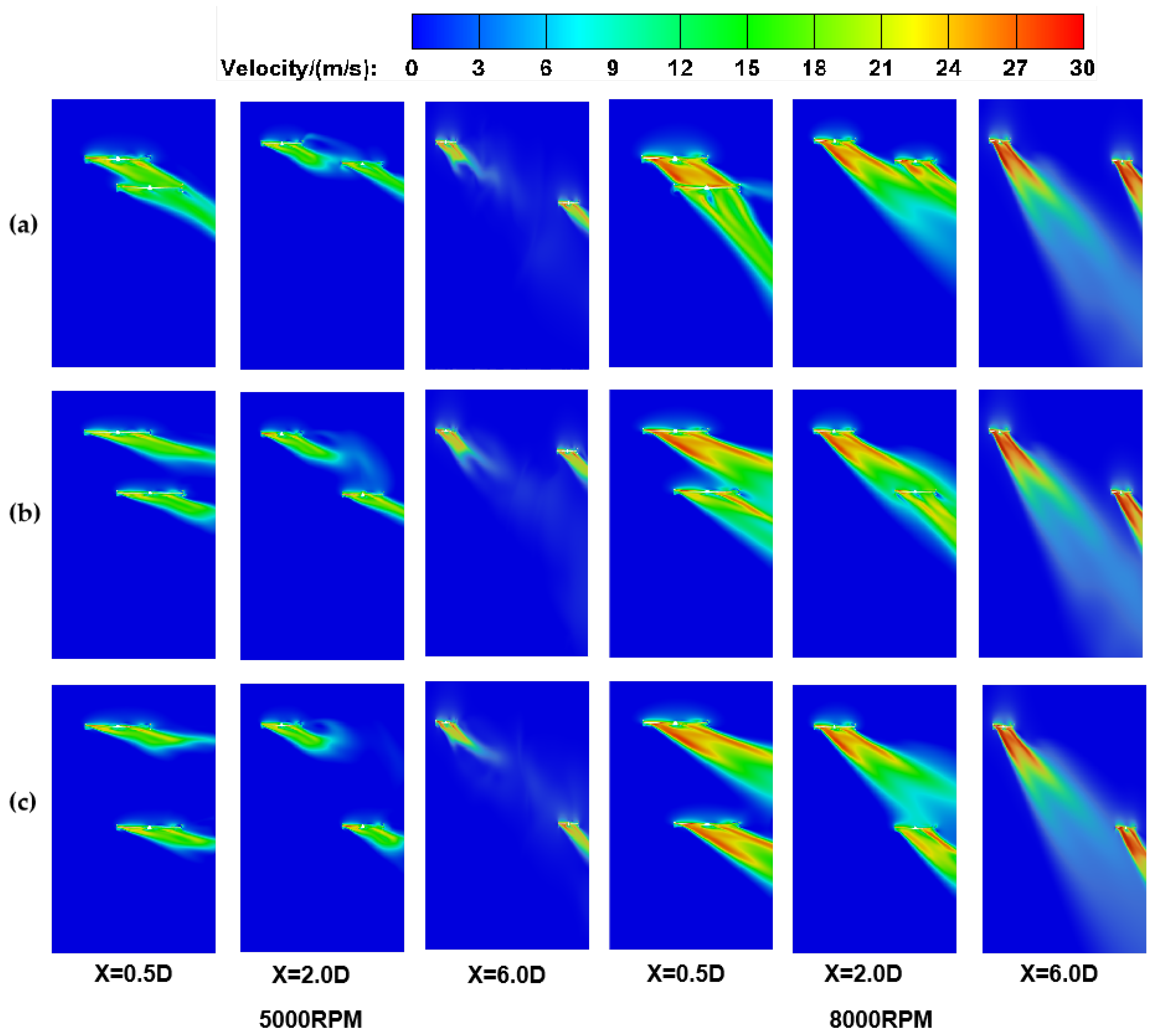
| Flight State | Variable | Values |
|---|---|---|
| Hover | RPM | 2000–8000 |
| X/D | 0, 0.25, 0.5, 0.75, 1 | |
| Z/D | 1, 3, 5, 7.5, 11 | |
| Vertical | RPM | 2000–8000 |
| X/D | 0, 0.25, 0.5, 0.75, 1 | |
| Z/D | 1, 3, 5, 7.5, 11 | |
| Velocity | 2 m/s, 5 m/s | |
| Horizontal | RPM | 2000–8000 |
| X/D | 1, 2, 3, 4, 6, 8, 10 | |
| Z/D | 0.5, 1.5, 2.5 | |
| Velocity | 2 m/s, 5 m/s, 10 m/s, 15 m/s |
Disclaimer/Publisher’s Note: The statements, opinions and data contained in all publications are solely those of the individual author(s) and contributor(s) and not of MDPI and/or the editor(s). MDPI and/or the editor(s) disclaim responsibility for any injury to people or property resulting from any ideas, methods, instructions or products referred to in the content. |
© 2024 by the authors. Licensee MDPI, Basel, Switzerland. This article is an open access article distributed under the terms and conditions of the Creative Commons Attribution (CC BY) license (https://creativecommons.org/licenses/by/4.0/).
Share and Cite
Liu, C.; Li, B.; Wei, Z.; Zhang, Z.; Shan, Z.; Wang, Y. Effects of Wake Separation on Aerodynamic Interference Between Rotors in Urban Low-Altitude UAV Formation Flight. Aerospace 2024, 11, 865. https://doi.org/10.3390/aerospace11110865
Liu C, Li B, Wei Z, Zhang Z, Shan Z, Wang Y. Effects of Wake Separation on Aerodynamic Interference Between Rotors in Urban Low-Altitude UAV Formation Flight. Aerospace. 2024; 11(11):865. https://doi.org/10.3390/aerospace11110865
Chicago/Turabian StyleLiu, Cong, Baiqing Li, Zhiqiang Wei, Zongwei Zhang, Zezhong Shan, and Yu Wang. 2024. "Effects of Wake Separation on Aerodynamic Interference Between Rotors in Urban Low-Altitude UAV Formation Flight" Aerospace 11, no. 11: 865. https://doi.org/10.3390/aerospace11110865
APA StyleLiu, C., Li, B., Wei, Z., Zhang, Z., Shan, Z., & Wang, Y. (2024). Effects of Wake Separation on Aerodynamic Interference Between Rotors in Urban Low-Altitude UAV Formation Flight. Aerospace, 11(11), 865. https://doi.org/10.3390/aerospace11110865






